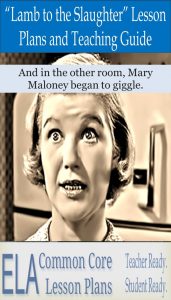I won’t go into too much detail about the first time I taught “Lamb to the Slaughter.” Let’s just say, I was the lamb.
Then I created these “Lamb to the Slaughter” Lesson Plans (like this one on irony in “Lamb to the Slaughter”). But before we get into these “Lamb to the Slaughter” lesson plans and review, it’s time for a clever introduction.
The classroom was warm and clean, the curtains drawn, the two burnt out flourescent lamps replaced—hers and the one by the empty chair opposite. On the white board behind her, two tall glasses, soda water, whiskey. Fresh ice cubes in the Thermos bucket.
Mary Maloney was waiting for her principal’s evaluation before going home from work. If only she had used these “Lamb to the Slaughter” activities and lessons, she wouldn’t have stuffed a giant, frozen leg of lamb in her purse, just in case the meeting didn’t go well.
“Lamb to the Slaughter” Summary

Ever feel like you’re the lamb about to get slaughtered in the classroom? The “Lamb to the Slaughter” Teaching Guide contains lesson plans, graphic organizer handouts with answer keys, essay rubrics, a summary and analysis of the story, discussion ideas, a quiz, and more. Lessons focus on irony, theme, plot, characterization, point of view, literary analysis, and more.
A pregnant Mary Maloney awaits her husband’s arrival. He arrives. The two enjoy a before dinner cocktail. Mr. Maloney is acting weird because he’s about to divulge something to his wife. He tells her the news—the reader does not know exactly what he tells her—that leaves Mrs. Maloney in a state of shock.She pretends whatever it was he told her isn’t true and starts to make dinner. She pulls a frozen leg of lamb out of the freezer and carries it into the living room where her husband insists he’s leaving.
She strikes him over the head with the frozen meat and kills him.
Mary then heads to the market to buy vegetables, pretending nothing happened. When she arrives home, she finds her husband on the floor, murdered.
She calls the police department. Several officers arrive. They search the house for the murder weapon. Mary offers them whiskey and then she asks them to eat the meal—the leg of lamb—she’d prepared for her husband.
They reluctantly agree and enjoy a delicious leg of lamb while discussing what could have happened to the murder weapon.
“Lamb to the Slaughter” Analysis
- Irony. A lot of what happens in this dark tale is not what I expected—a pregnant woman bludgeoning her husband with a frozen leg of lamb, for example, and then acting surprised her husband’s been murdered. The verbal irony as the detectives investigate is priceless. Yes, priceless!
- Pun. Lamb to the slaughter is a play on words involving the murder instrument and the death of someone who is unaware. The connotation that lambs are innocent makes one question who the lamb is. Is it the wife? Is it the husband? Is it the lamb?
- Character Analysis. Mild mannered housewife or ruthless murderer?
- Allusion. The story’s title is an allusion to the Bible most commonly associated with the crucifixion of Jesus—metaphorically referred to as “The Lamb of God.”
Life is good when your short story lesson plans are finished for the year.
- Plot. Is the murder the climax and everything that ensues the falling action? Or is the murder the rising action and the detective’s search and destruction of the murder weapon the climax?
- Making Inferences. Much of what happens in “Lamb to the Slaughter” must be inferred by the reader.
- Narrative Writing. Three options present themselves: (1) Write the missing dialogue, using inferences; (2) Write a story extension; (3) Write a scene from the husband’s point of view.
“Lamb to the Slaughter” Lesson Plans and Activities
- Plot Analysis with Story Map
- Analyzing Irony with Irony Explanation and Analysis Chart (Download this specific lesson with a click)
- Making Inferences Lesson with Analysis Chart
- Writing an Objective Report with Instructions, Handout, and Assignment Specific Rubric
- Narrative Writing Handout with Assignment Specific Rubric
- Character Motivation Analysis Handout with Questions and Analysis Chart
- Quiz with Answer Key: 10 Multiple Choice Questions and 2 Essay Questions with Organizational Helps
Recommended Unit Length: 5-7 Days
Recommended Grade Level: Middle School (Most Assignments), High School, Home School
Recommended Student Level: All (Lessons can be easily scaled for differentiation)
Last Updated on May 2, 2018 by Trenton Lorcher
Share This:
